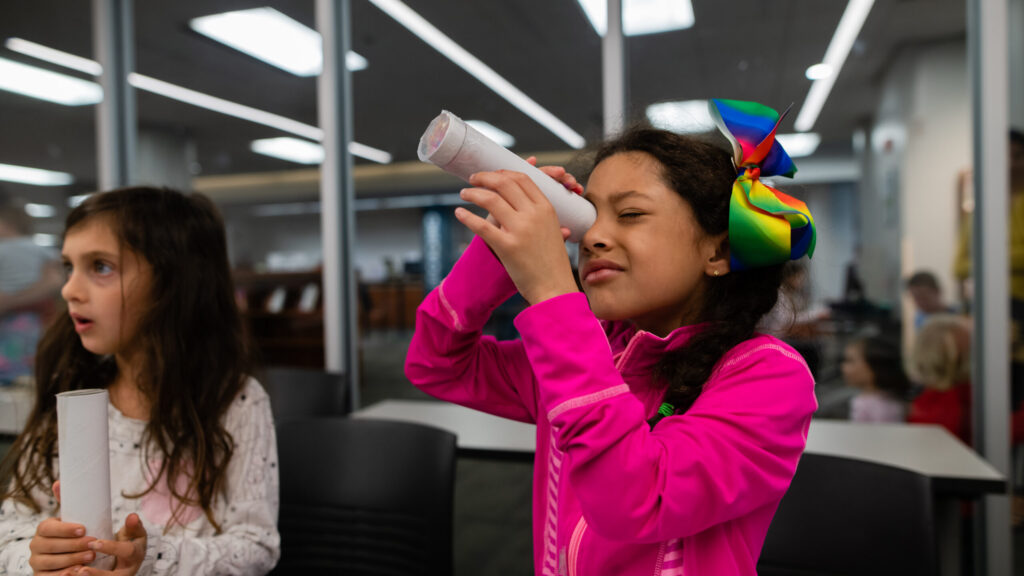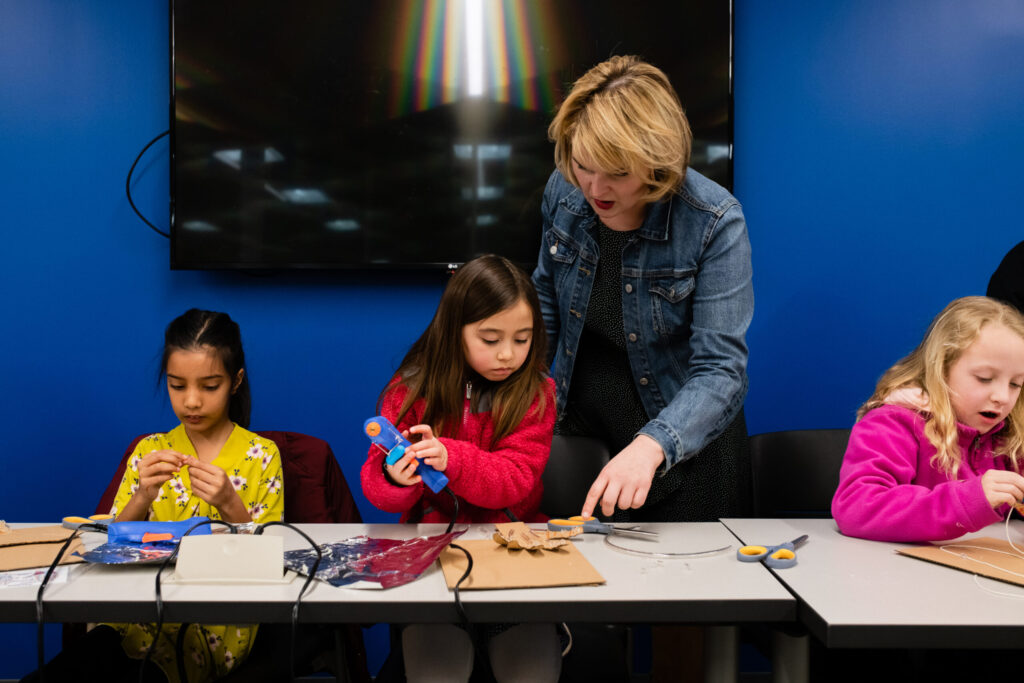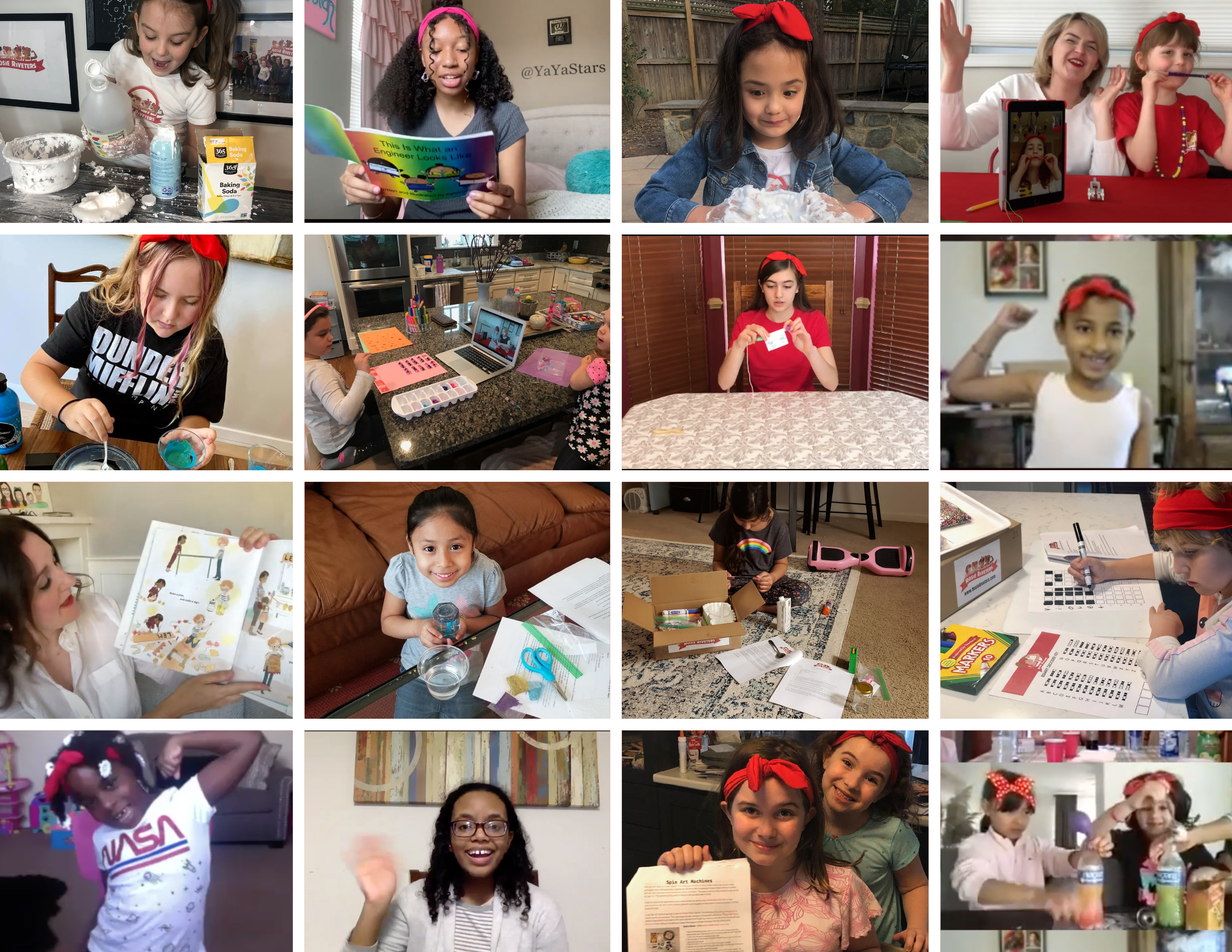The 2021 version of Rosie Riveters, named for the iconic World War II poster, allows school girls to build, create and practice critical STEM life skills.
It’s a typical Pre-COVID Saturday morning. We’re starting a Rosie Riveters four-week STEM program and after a quick, interactive lesson on a scientific concept, our new cohort of Rosie girls, as we affectionately call them, has been set loose to build and create a hydraulic desk lamp. There’s a table full of materials at the front and a few examples of the completed lamps stationed around the room. It’s an atmosphere of possibility; the girls, ages seven to nine, aren’t given formal instructions.
Instead, volunteer mentors and the teacher remind them to “look at the example;” it serves as their guide to selecting their materials and building the hydraulic system. Moreover, as long as the lamp uses hydraulics to move in some fashion, the girls can design it any way they’d like.
To elementary-school science teachers and nostalgic postsecondary STEM students, it sounds like a dream. Yet the refrain resounding through the room is one of “this isn’t fair,” or “it’s too hard,” often accompanied by low grumbles and furrowed brows. This reaction to a relatively unstructured learning activity where the learning process takes priority over finding a concrete and “correct” answer is, in fact, typical with this age group and gender.
It results from the mutually reinforcing combination of girls’ decreasing confidence in their innate intellectual ability and the fixed mindset many develop as they move through the early years of their formal education. These same factors are incredibly detrimental to a young woman’s engagement with STEM and a future career in the field.

In 2017, Science published a report detailing this devastating confidence drop. Studying a group of 400 children from largely white, middle-class households (although race/ethnicity/socioeconomic status did not moderate results across studies), the authors found that at age five, “boys and girls associated brilliance with their own gender to a similar extent.”
Yet, a mere year later, girls began to lose confidence in their intellectual abilities, becoming “significantly less likely than boys to associate brilliance with their own gender” and demonstrating less interest in games that were said to be for “children who are really, really smart.” The same study also demonstrated that girls in this age group failed to link “brilliance” with working hard or getting good grades; being “really really smart” was innate and distinctly male.
This decreasing confidence and notion of innate, male brilliance is complicated and reinforced by the fixed mindset that many girls develop during preschool and early elementary. As Katty Kay and Claire Shipman described in a 2014 Atlantic synopsis of their book Confidence Code, published the same year, “girls get a lot of praise for being perfect.” They went on, paraphrasing the seminal work of bestselling author Carol Dweck on mindset, noting, “the result is that many girls learn to avoid taking risks and making mistakes” in an effort to remain “good” while boys, who are constantly criticized and urged to exert more “effort” in order to achieve what girls are capable of in the classroom, become familiar and comfortable with failure.
Girls’ developmental advantage – being able to sit still and follow directions – thus turns on them, “fixing” them into a state where failure is feared. Add to that their decreasing confidence in their own intellectual abilities and the simultaneously emerging belief that being “really, really smart” is inherently male, and the result is young women who work hard to attain praise rather than “brilliance,” who avoid situations and subject matter where mistakes are likely to be made, who succeed academically while simultaneously believing that they are not as smart as their male peers.

Yet this is the exact inverse of the conditions and factors necessary to reverse the gender disparity in STEM. According to findings in Closing the STEM Gap, a report based on a 2018 quantitative research study conducted by Microsoft and Southern Utah State University, growth mindset and a supportive and encouraging environment – i.e., one that builds confidence – are listed as primary drivers to enhancing girls’ engagement with STEM. While the Microsoft study surveyed girls aged ten and older to arrive at their recommendations, our organization believes, and our classroom experience and the research outlined above corroborates, that these supports must be in place earlier than fifth grade as the conditions that are detrimental to STEM engagement begin at age five.
How do we, as an organization, begin to shift this mindset for seven- to nine-year-old girls and move from “this is too hard” to “I can do this”? At the most basic, our programs create a safe place to fail. We are a female-driven program, the majority of our participants are young women (as are our teachers and volunteers), in order to foster a learning environment where gender-driven comparisons are less likely to be made. Moreover, we are an afterschool, weekend, and summer program. Our participants are not in a school environment, and there isn’t one “right” way to build a project. As the hydraulic lamp project above exemplifies, participants typically have only one criteria they must meet; otherwise they are free to design and create as they see fit. Overall, they aren’t worried about earning a grade and the pressure to achieve the “right” result (i.e., a good grade or a “perfect” project) is removed.
When we created the program, we were simultaneously invested in creating a process that would encourage failure while ultimately overcoming it via the project’s design. This takes independence, encouragement, and ample time. As mentioned above, the building portion of our program is based on trial and error.
Our participants are given examples of projects to examine and work from and a table full of materials; there are no directions. They will inevitably (and intentionally) fail as they attempt to create their own project from that example, and our teachers and volunteers normalize that failure as a part of the process.
With a nearly 4:1 student-to-teacher ratio, there is ample opportunity for individual encouragement and interaction, and the phrase teachers and volunteers repeat over and over again as they examine projects and troubleshoot is “Take a look at the example. What do you see?” Add “You can figure this out” and “keep trying” and you’ve covered the majority of the phrases we use the most when teaching and mentoring.
Lastly, participants have ample time to make and correct mistakes; we set aside nearly one-and-a-half hours per session to create, build, and fail. Failure breeds confidence when you’re allowed to figure it out for yourself, and as we repeat the exercise in each session, our participants build confidence and begin to foster a growth mindset. We hear less and less “it’s too hard” and “this isn’t fair” as each week goes by.
Our participants and their parents attest that our approach is working.

“I have been a part of Rosie Riveters for over four years,” writes one participant, who began attending when she was in third grade. “[It] has given me the chance to explore my passions in STEM…[and] has always been a safe environment for me to learn. While the wonderful volunteers are always available to help us during projects, they teach us that it is better for us to untangle an issue through trial and error ourselves.”
As a parent put it, “Rosie Riveters has truly allowed my daughter to feel confident and brave in standing out, and I’m incredibly grateful for the opportunity to be part of such an incredible organization.” And, in the insightful words of a sixth-grader, “I believe that it is vitally important that little kids (especially young girls) be introduced to science at a young age before they [begin to believe that] science isn’t “cool.”’
It is “vitally important” that we begin the work of untangling the dual factors of decreasing confidence and fixed mindset that ultimately prevent so many young women from pursuing STEM – both academically and as a career – as early as possible. Our organization knows how, and as we recite with our participants at the end of each session, complete with arm crooked just like the original Rosie the Riveter, “we can do it.”
KATHERINE RIEDER is a co-founder and director of Rosie Riveters, which serves girls from pre-school to middle and high school with STEM curriculum, project-based learning and creating an enduring growth-oriented mindset. Go to http://rosieriveters.com.











